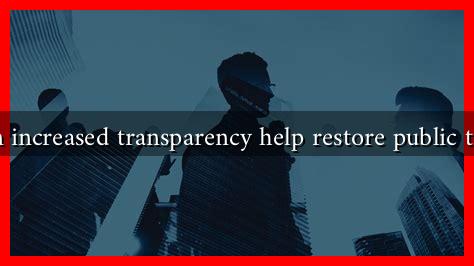-
Table of Contents
Can Increased Transparency Help Restore Public Trust?
In recent years, public trust in institutions—be it government, corporations, or non-profits—has plummeted. Scandals, misinformation, and perceived corruption have left many citizens feeling disillusioned. As a response, the concept of transparency has emerged as a potential remedy. But can increased transparency genuinely restore public trust? This article explores the relationship between transparency and trust, supported by examples, case studies, and statistics.
The Importance of Transparency
Transparency refers to the openness and clarity with which organizations operate. It involves making information accessible and understandable to the public. The importance of transparency can be summarized in the following points:
- Accountability: Transparency holds organizations accountable for their actions, making it harder for them to engage in unethical behavior.
- Informed Decision-Making: When information is readily available, stakeholders can make informed decisions based on facts rather than speculation.
- Engagement: Transparency fosters a sense of involvement among the public, encouraging them to participate in discussions and decision-making processes.
Case Studies: Transparency in Action
Several organizations have successfully implemented transparency initiatives that have led to increased public trust. Here are a few notable examples:
1. The City of San Francisco
In 2012, San Francisco launched an initiative called “Open Data,” which aimed to make city data accessible to the public. This initiative allowed citizens to access information on everything from crime statistics to public spending. As a result, the city saw a significant increase in public engagement and trust. According to a survey conducted by the city, 70% of residents felt more informed about local issues due to the availability of data.
2. Patagonia
Outdoor clothing company Patagonia has built its brand on transparency. The company openly shares information about its supply chain, environmental impact, and labor practices. This commitment to transparency has resonated with consumers, leading to increased brand loyalty and trust. A 2020 survey found that 73% of Patagonia customers felt the company was honest about its practices.
Statistics Supporting Transparency
Research supports the notion that transparency can lead to increased trust. A study by the Edelman Trust Barometer found that:
- 81% of respondents said they need to trust a brand to buy from them.
- 62% of respondents stated that they would buy from a company that is transparent about its business practices.
- 57% of respondents indicated that they would advocate for a brand that demonstrates transparency.
These statistics highlight the growing demand for transparency among consumers and the potential benefits for organizations that embrace it.
Challenges to Implementing Transparency
While the benefits of transparency are clear, implementing it is not without challenges. Some of the key obstacles include:
- Resistance to Change: Organizations may be reluctant to change their practices, fearing backlash or exposure of negative information.
- Information Overload: Providing too much information can overwhelm the public, making it difficult for them to discern what is relevant.
- Privacy Concerns: Organizations must balance transparency with the need to protect sensitive information.
Conclusion: The Path Forward
Increased transparency has the potential to restore public trust in institutions, as evidenced by successful case studies and supporting statistics. However, organizations must navigate the challenges of implementation carefully. By committing to transparency, organizations can foster accountability, informed decision-making, and public engagement.
Ultimately, the journey toward restoring public trust is ongoing, and transparency is a crucial step in that direction. As more organizations embrace transparency, we may witness a gradual rebuilding of trust between the public and the institutions that serve them.
For further reading on the importance of transparency in building trust, you can visit Edelman’s Trust Barometer.

